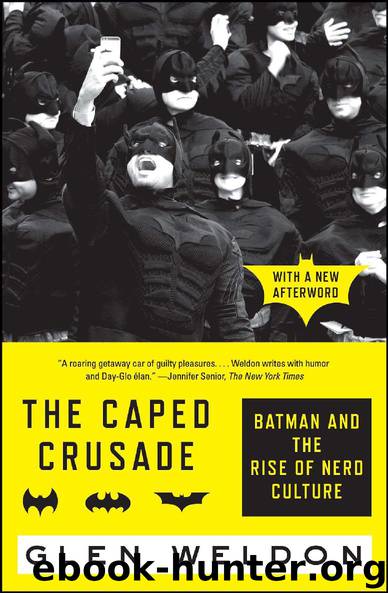The Caped Crusade by Glen Weldon

Author:Glen Weldon
Language: eng
Format: epub
Publisher: Simon & Schuster
BAT-BUMP, OR BAT-BUBBLE?
The success of the Batman film did precisely what DC Comics desperately hoped it would: it drove new buyers—normals and lapsed nerds alike—into comics shops. There they found stand-alone, new-reader-friendly Bat-books like The Dark Knight Returns, The Killing Joke, and Year One.
In September, any normals who wandered into a comics shop found a brand-new monthly Batman comic waiting on the shelves—one aimed squarely at them. Batman: Legends of the Dark Knight presented new tales that focused on a Caped Crusader just beginning his crime-fighting career.
The other monthly Bat-books churned blithely on through the murky waters of their nerd-focused backstories: in a tale that stretched over half a year’s worth of Detective Comics, a savvy thirteen-year-old boy named Tim Drake (who had figured out Batman’s secret identity at age nine) noticed that his hero’s behavior was growing more erratic in the absence of Robin. He sought out Dick Grayson to entreat him to give up his identity as Nightwing, become Robin once again, and rejoin his mentor. When Grayson refused, Tim Drake became the third Robin himself.
The pages of Legends of the Dark Knight, on the other hand, contained lean and muscular stories that could be picked up and understood without AP-level Bat-knowledge.
This was intentional—strategic, even. Earlier in the year, Warner Communications (which owned DC Comics) had merged with Time Inc. to form Time-Warner. This meant that DC was now a part—albeit a small one—of what was suddenly the largest media conglomerate in the world. The company now had access to more resources than ever to promote, market, and merchandise its characters, and—almost as an afterthought—the comics in which they appeared.
The appearance of Legends of the Dark Knight in comics shops changed the comics landscape. Over and above its appeal to curious new readers, its status as the first solo Batman title introduced since 1940 (a fact prominently spelled out on the special “collectors edition” cover) made it attractive to speculators—collectors who bought multiple issues and squirreled them away to await the day they would markedly increase in value. The fact that DC released the first issue of Legends of the Dark Knight with different covers in a range of special-edition colors ensured that the title would have sold well to collectors even if Batman hadn’t just starred in a major Hollywood blockbuster. Legends of the Dark Knight became the top-selling comic of the year. Astonishingly, its surging sales, combined with those of the other Bat-titles, effectively doubled the size of the American comics industry in the span of a few short months.
It was during this period that an odd, and oddly gorgeous, tone poem of a Batman story appeared in comics shops. Arkham Asylum: A Serious House on Serious Earth was a “prestige hardcover edition” written by a young Grant Morrison with art by Dave McKean that looked and felt like nothing DC Comics had published before.
By this time, “grim and gritty” had become the default narrative mode of comics. Marvel’s Punisher, a machine-gun-toting, mass-murdering vigilante, introduced in
Download
This site does not store any files on its server. We only index and link to content provided by other sites. Please contact the content providers to delete copyright contents if any and email us, we'll remove relevant links or contents immediately.
| Books & Reading | Comparative Literature |
| Criticism & Theory | Genres & Styles |
| Movements & Periods | Reference |
| Regional & Cultural | Women Authors |
4 3 2 1: A Novel by Paul Auster(11027)
The handmaid's tale by Margaret Atwood(6834)
Giovanni's Room by James Baldwin(5868)
Big Magic: Creative Living Beyond Fear by Elizabeth Gilbert(4714)
Asking the Right Questions: A Guide to Critical Thinking by M. Neil Browne & Stuart M. Keeley(4558)
On Writing A Memoir of the Craft by Stephen King(4203)
Ego Is the Enemy by Ryan Holiday(3978)
Ken Follett - World without end by Ken Follett(3967)
The Body: A Guide for Occupants by Bill Bryson(3787)
Bluets by Maggie Nelson(3703)
Adulting by Kelly Williams Brown(3662)
Guilty Pleasures by Laurell K Hamilton(3577)
Eat That Frog! by Brian Tracy(3502)
White Noise - A Novel by Don DeLillo(3428)
The Poetry of Pablo Neruda by Pablo Neruda(3357)
Alive: The Story of the Andes Survivors by Piers Paul Read(3300)
The Bookshop by Penelope Fitzgerald(3220)
The Book of Joy by Dalai Lama(3211)
Fingerprints of the Gods by Graham Hancock(3205)
